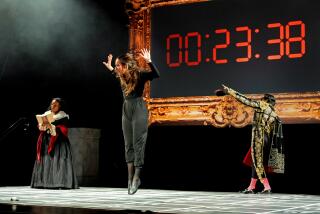Obsession for Musical Expression : Jazz: Bruce Lofgren, who plays guitar tonight at El Matador, has composed more than 700 works. Writing music, he says, is ‘just a love, I guess.’
- Share via
Bruce Lofgren is one of those people you’d expect to see driving around in a car with that bumper sticker that reads, “Life without music would be a mistake.”
“If I have free time, I take out the guitar and start putting ideas down, sorting them out. It’s just a love, I guess,” says the guitarist, composer and bandleader.
Music allows Lofgren, who fronts his 15-piece Jazz Orchestra tonight at El Matador in Huntington Beach, a means of expression that he doesn’t often find in everyday living.
“In your interactions with people, you can’t always be as expressive as you want to be,” he said. “But in music, I can take ideas and see how they work together. That’s a joy.”
Organized sound also affords Lofgren a way to move listeners, jog their minds, make them think and feel. “Music gives me an opportunity to tell a story in a way that listeners can’t always predict how it will come out, or, if they can, can’t predict how they will get to that conclusion.”
Though he’s played guitar since he was 12, composition rather than performance seems to be Lofgren’s main medium. He began writing tunes in 1967 and has since amassed more than 700 original works. About 200 of those have been orchestrated for a large jazz ensemble. The late Buddy Rich and Doc Severinsen’s “Tonight Show” Orchestra are among the artists who have recorded Lofgren compositions.
Like many jazz musicians today, Lofgren, 48, has eclectic musical tastes. A native of Seattle who now lives in Alhambra, Lofgren says his first heroes were rockers: Chuck Berry, Jerry Lee Lewis, the Beatles and the Rolling Stones. He discovered jazz at age 14, via a record by guitarist Tal Farlow, and decided to make it a focus three years later when he heard guitarist Barney Kessel in a club in Vancouver, B.C.
“I was totally sucked into the world of jazz at that point,” he said.
But Lofgren’s originals don’t stop with jazz and rock, he said. There are elements of the classics, of Brazilian and Latin music, of New Age and more.
“I don’t have any allegiance to any one idiom or language,” he said. “My idea is to use whatever tools I can to express a musical idea. Some of my pieces are through-composed, where there are no solos. I am not committed to the traditional jazz-band direction. I don’t want to say, ‘This is a jazz band, and we can’t do that.’ Which doesn’t mean I don’t like traditional jazz bands, such as Bill Holman or Bob Florence. It’s a joy to hear any kind of music that’s done well.”
A typical Lofgren piece, he says, is “Parables,” written in the unusual time meter of 7/8. “It starts out very intensely, with a lot of chordal movement,” he said. “Then it has a center section that gets very transparent, where there’s repeating thematic development that’s ultimately played by only a few instruments--light percussion and woodwinds. Then it builds from there to a boiling ending.”
The leader keeps about 50 pieces in his active file--”If I took everything to a job, the scores would be too heavy to carry,” he joked. Most of these are newer works, because they reflect how far Lofgren feels he has evolved in his craft. But new does not always translate into original , he’s discovered.
“You finish a score, it looks great, feels fresh,” he says. “But then after you play it 14 or 15 times, there are things that become hackneyed, that you can’t stand the sound of. That’s why artists have to re-edit their work. I have things from the ‘70s that I still play but not without a certain internal cringe, thinking what I’ve learned.”
One facet he thinks characterizes his current output is its leanness. “The idea is to do it better in less space, because the more you put in, the less you get out,” he said. “You get an idea, you think it’s great, there’s that soaring feeling of creativity. Then you have to come to the acid reality: Is this important or has it been done a hundred times? Is it truth or is it BS?”
Lofgren began arranging in 1967 for an eight-piece Seattle-based band called the Pacific Northwest Territory, and knocked out his first big band composition while studying arranging at Olympic College in Bremerton, Wash. In Los Angeles, Lofgren found success writing for such pop stars as Kenny Loggins and Jim Messina, as well as for such jazz artists as Rich. He also toured with Flora Purim and Airto Moreira.
Lofgren formed his large ensemble during this period. The group, which made the album “Move Into the Car” (Phoenix Records), rehearsed and performed until 1986, when the leader disbanded it for a number of reasons, mainly for lack of a regular performance space. In 1988, he organized a sextet, both as a vehicle for playing--he remains active as a guitarist--and as a place to hear his music.
The Jazz Orchestra was recently revived by Lofgren, who found that almost “100% of the players who used to play with me wanted to do it again.”
The band’s current weekly rehearsals provide Lofgren with instant charge of hearing what he writes. “It’s such an exciting experience,” he said, “like being a painter and seeing right away how the canvas you just finished works out.”
* The Bruce Lofgren Jazz Orchestra plays tonight at 8:30 & 10:30 at El Matador, 16903 Algonquin St., Huntington Beach. Admission: $5. Information: (714) 846-5337.
More to Read
The biggest entertainment stories
Get our big stories about Hollywood, film, television, music, arts, culture and more right in your inbox as soon as they publish.
You may occasionally receive promotional content from the Los Angeles Times.










